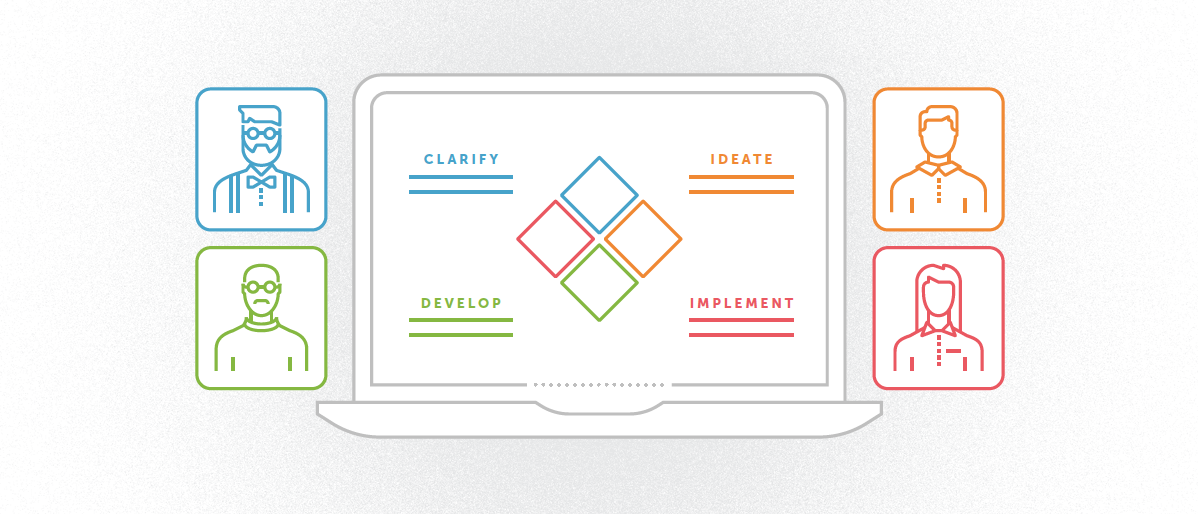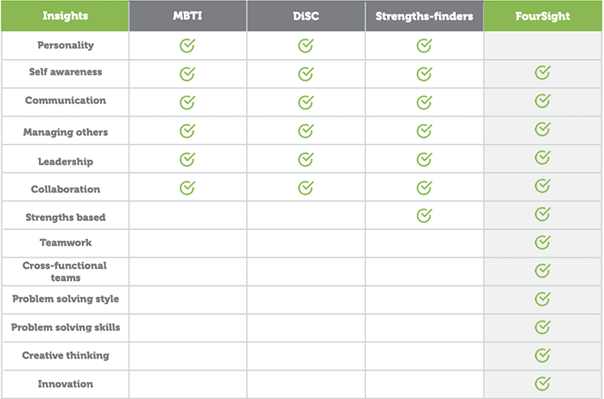Effective Strategies for Enhancing Collaboration in Remote Teams
Posted on October 27, 2021

Learn how your team can collaborate better together, apart. In this guide, we’ll look at the upsides and downsides of remote work, and explore how a team assessment tool like FourSight can transform collaboration.
With more than 4.7 million people in America working remotely at least half the time, remote work is becoming increasingly common. In fact, by the year 2025, experts predict that 22% of Americans will be working remotely.
As it turns out, according to a recent Buffer study, 97.6% of respondents said they’d actually prefer to work remotely, at least some of the time, for the rest of their careers.
Remote work, it seems, is here to stay.
But how do you collaborate effectively when working remotely? There are a number of unique issues to overcome — issues related to how we communicate with one another across the miles and hours that separate us, as well as how that distance impacts our ability to collaborate with a team of people we may have never met.
In this guide, we’ll discuss some of the common hurdles remote teams face, the benefits of working remotely, good methods of managing a remote or hybrid team, ways to understand your remote team members better, how and why team problem-solving style assessments can help your team members collaborate smarter, and how to choose the best team assessment tool for your team.
Understand Remote Collaboration

Virtual collaboration, or remote collaboration, happens when a team of people are working remotely on a common goal using virtual tools, such as video conferencing tools, task tracking and management tools, and a file sharing system.
Put simply, virtual collaboration means your team is working together, apart.
What is hybrid collaboration?
While some teams are working on a fully remote basis, many are working on hybrid teams. This means that a portion of the team is working from home, while the rest are still working in a traditional office setting.
In some cases, individual team members are finding that working remotely two or three days a week and heading to the office the other days works best for them, especially when it comes to engaging in healthy social interactions.
What are the Advantages of Working Remotely?

During the 2020 COVID pandemic and subsequent shutdown, many teams were forced to go virtual, prompting fears that productivity rates would plummet. Shockingly, however, that’s not what happened for many organizations.
According to one study, 94% of employers surveyed reported either that their productivity rates had stayed the same or even increased as compared to pre-COVID times, shattering the oft-repeated argument that team members must be directly, physically observed to be accountable for their work.
The findings changed employers' views of remote work and its viability. It also changed workers’ views. Remote workers reported being happy at work 22% more often than those workers who were forced to head to the office every weekday. They also reported feeling less stressed, more able to focus, and better able to manage their work/life balance.
In less than a years’ time, both organizations and workers suddenly began to believe that remote work could actually work. Aside from the many advantages to each individual employee — including the average $7,000 per year saved on transportation, food, and childcare costs — let’s look at some of the ways in which your team can benefit from working remotely, or from maintaining a hybrid work schedule.
Flexible Schedule and Work/Life Balance
For one thing, working remotely means that team members can have their cake and eat it, too. With a flexible schedule and the freedom to work from anywhere, each team member is able to both do their very best work and live a more freeing lifestyle.
Consider this story as a case in point. Phil runs a public storage facility in Chicago and rents a beautiful home with a pool in South Carolina. Amid the stay-at-home orders with schools still closed, he drove his young family there in November to stay for a month. He was able to enjoy a change of scenery and spend quality time with his family – all while running his business remotely from his laptop.
What’s more, an asynchronous work schedule gives each individual team member the freedom to work during their own personal peak energy and creativity times rather than being forced to work according to a more traditional 9-5 schedule.
This means that rather than fitting some life into their work schedules, remote team workers are better able to fit their work into the lifestyle of their choosing, elevating their mood and helping them maintain a more healthy life and work balance.
Less Commuting, More Incubating
What’s more, a remote team working environment means that rather than spending hours in traffic commuting to work each day, remote team meetings give team members the chance to spend that time processing team input and projects, as well as ideating their own visions for the benefit of the team.
A remote working environment allows a natural buffer between meeting, planning, and implementation, giving each team member the opportunity to more fully process and plan for how best to implement the strategies discussed in remote team meetings.
What Are the Challenges that Come with Collaboration with Remote Teams?

Whether your team is fully remote or you’re operating on a more hybrid level, healthy communication at work is more important than ever before. In fact, 16 percent of remote workers in a recent study said that communication and collaboration issues were the most stressful part of their job.
But what is it about working remotely that creates so many added communication issues?
Eloise: The Virtual Team Disconnect
Eloise, a new college grad, found herself sitting in a virtual onboarding call for her first real job. Her teammates — so many talking heads on the screen in front of her — seemed bright, inviting, and capable. More than this, they seemed genuinely excited to work with Eloise.
But weeks later, Eloise struggled to complete her work assignments. Sure, she knew who her immediate supervisor was and he was helpful enough, but there were so many questions she had for other team members — people she had never met in person, who lived halfway around the world from her.
Without the chance to interact with them in a break room or stop by their desks for the occasional chat, she felt disconnected and forgotten. Eloise began to fall behind in her work, leaving both Eloise and her team leader bewildered. She was, after all, perfectly qualified for the position.
Eloise, unfortunately, is not a rare case, especially in our increasingly virtual workforce. Researchers at the University of Michigan found that virtual collaboration is much more likely to succeed if people have already met in person. New hires, who have never met their colleagues in person, often remain a face on a screen. It’s hard for coworkers to get to know them and what makes them tick.
Role Confusion
When working remotely, team efforts can become convoluted. It can be hard for team members to be clear on their own personal responsibilities, leading to an overall breakdown in collaborative efforts, especially when it comes to task management. Without a clear communication line, tasks may be neglected, unnecessarily duplicated, or even forgotten altogether.
But what causes this sense of role confusion? Why do otherwise functional teams struggle so much when it comes to collaboration with remote teams?
There are five types of team disconnect that lead to role confusion.
1. Physical Distance
In some cases, the actual, geographical distance between team members — especially when it’s large enough to mean they live in different time zones — impacts their ability to work together effectively.
2. Operational Disconnect
When working remotely, a team is not able to engage in the everyday face-to-face interactions they’d typically have when working on-site. This means they don’t get the chance to build a sense of mutual trust that keeps a team feeling like, well… a team! Without the chance to get to know one another more naturally, there can be a disconnect surrounding values and work ethic, as well.
3. Lacking Affinity
If your remote team is made up of many people, it can be even harder to collaborate effectively when you’re working remotely than it would be when everyone is working in the same building. Likewise, when people are working remotely, their varying internet bandwidth and speed can make communication even harder than usual. Finally, if your team members are operating on different skill levels, this can also contribute to an overall sense of distance.
4. Lack of Direction & Coordination
When managing a remote team, one of the challenges you may face is that your team members may seem to struggle with getting started on their tasks. The problem can almost always be traced back to a lack of clear direction from team leadership.
Setting clear expectations for your remote team is even harder than usual because of the typically text-based type of communication remote teams often engage in, where there is ample room for misinterpretation.
Sometimes, directions may have been clear, but team members are unsure how to coordinate with one another, creating a gap in the work process, leaving tasks unfinished and projects in the lurch.
5. Lack of Inspiration
Nothing is more frustrating than watching an otherwise productive, valuable member of your team struggle to meet your expectations, and for no apparent reason. In cases such as these, oftentimes the culprit is hard to pin-point — a vague lack of inspiration.
When your team members feel uninspired to bring their best ideas and skills to the table, often what’s lacking is a sense of their own part in the overall mission of the organization. This sense of a mutual investment in the shared goals of the team is harder to remedy in a remote work environment because there is less opportunity for team-building.
How to Improve Collaboration with Remote Teams

So now that we understand the challenges that come with collaborating remotely or in a hybrid situation, what steps can you take to better your collaboration efforts?
Kyong: In Search of Better Leadership
Kyong, the head of a private PR firm, had been managing his team for several years, and felt satisfied with his work. But his team members privately complained to one another about the lack of direction in his leadership style.
It seemed like he was aloof to their concerns and continued to use the same tactics that had landed him the management position so many years ago. Without the challenge of new leadership training, Kyong continued on his path, confused as to why his team members seemed to perpetually fall short of his expectations.
Sometimes, when a remote team seems to be struggling with communication and collaboration, the problem isn’t with the remote team but with the leader. Unlike Kyong, an effective remote team leader understands that it’s their responsibility to inspire, direct, monitor, and motivate their team to give their personal best to the team.
Leadership Training
If your team members seem to be struggling, consider taking a leadership training course. More than ever before, it’s necessary for team leaders to learn the strengths and weaknesses of their own management style, as well as those of their team members.
With solid leadership training, one can be sure that the issues which arise from managing a remote or hybrid team are not coming from the top, down.
Weekly One-on-One Check-ins
Sometimes, the reason your team is struggling to work together comes down to a lack of face-to-face connection between team leaders and team members.
When a team member feels as if they are a valued, crucial part of the whole — and that their work is crucial to the success of the team — they are more likely to give their all.
One of the easiest, simplest ways to make sure each team member feels heard, seen, and respected is to check in with them once a week. In these short meetings, ask two key questions: 1. What are you working on this week? And 2. How can I help?
With just these two questions, you are communicating to your team members that you value their perspective and are invested in ensuring that they feel heard and seen. You also give yourself the chance to learn where your team members are focused, and how they’re feeling about it, thus informing your leadership tactics and decisions moving forward.
Online Team Building Activities
As stated above, one of the most common complaints from remote and hybrid workers is that they feel disconnected from their team members and from the overall mission of the company. We’ve all taken part in team-building exercises in person, but few are aware that there are plenty of these opportunities online, as well.
Virtual team-building exercises are a great way to give your team the chance to get to know one another and create a sense of community and comradery. But if you want to take your virtual teamwork to the next level, consider using an assessment as a team building exercise.
Team Assessment Tools
There are a variety of assessments for teams. Choose wisely. Make sure whatever assessment tool you choose is a valid and reliable measure, backed by research. Avoid assessments that pigeonhole people with potentially negative labels. Pick one designed to increase empathy, respect and appreciation for other team members.
That sort of assessment can help you uncover who your team members are, and how they best function within the team.
Think of a team assessment tool as a collective personality test, designed to help you and your team members better understand your unique gifts and talents, and the way your energies can best be leveraged for the good of the team.
Understanding Your Remote Team Members’ Unique Needs

When it comes to assessing your team members’ unique thinking styles and learning to use their talents in the best way possible, it’s important to re-consider a few of the underlying beliefs that drive ineffective team collaboration.
Kate & Fadi: Teammates at Odds
Kate and Fadi had been working together for a few years, mostly successfully. But there always seemed to be an issue when problems arose. For Kate, the way to solve a problem was to sit down with the team and brainstorm possible solutions.
For Fadi, though, Kate’s hare-brained idea sessions seemed like a waste of time. He much preferred that she email him the solutions she and the rest of the team had settled on so he could begin developing them into real plans.
Neither of them understood the value of the other’s thinking preferences—or how important each of them was to the running of the team. And like so many teams, they wasted energy and time butting heads on the best way to tackle issues.
Great Minds Don’t Think Alike
Contrary to popular belief, genius comes in all shapes and sizes. Each member on your team has a unique way of seeing the world, of processing information, of approaching problems, and of coming up with solutions.
When we expect our team members to operate like identical cogs in a machine, we are not only missing out on the valuable contributions they could make to the team, but we’re robbing the world of the unique ways those contributions could have made a difference.
If, instead, we chose to identify and respect the individual ways each team member thinks and works, we could open up endless possibilities of innovation.
Problem Solving Is a Universal Experience
Even though each member of your team is working within their own unique frame of reference, each of them is working through, more or less, the same four basic stages of problem solving:
1. Clarify
When we enter the clarify stage, our first job is to try to understand what’s happening. We ask questions. We gather data. We figure out: What, specifically, is the challenge we should be solving here?
Some people love to clarify. They are the people in the room who ask the clarifying questions that draw out information. They help the rest of the team to understand the situation more deeply. While high clarifiers ask the right questions, they may not have answers.
2. Ideate
Now that we’ve framed the right challenge to solve, it’s time to roll up our proverbial sleeves and begin to think creatively about ways to solve the challenge at hand. It’s time to expand our thinking beyond what is and ponder on what could be.
Some people love to ideate. They are the team members who have a seemingly endless list of ideas, but who may not be the most practical of problem solvers.
3. Develop
Once we’ve honed all the possibilities down to a shortlist of ideas, it’s time to evaluate and choose the most promising among them to develop into a solution.
Some people love to develop. They are the team members who are detail-focused and patient enough to map out a meticulous plan to implement the team’s new ideas. High developers may craft good plans, but have trouble implementing them.
4. Implement
The plan is clear. Now it’s time to put it into action. We need to do it, sell it, make it happen.
Some people love to implement. They follow the “just do it” motto when it comes to solving problems. They go right for action. They’ll push things across the finish line, but they could not have done it without the prior work of everyone else on the team.
Every problem that’s ever been solved, every project that’s ever been collaborated on — from the micro level to the macro level — has passed through each of these four thinking stages. And as it turns out, we are all more inclined toward one of them above the others.
Benefits fo Team Assessment Tools

In order to more effectively collaborate with your remote team, you need to better understand how each team member fits in the processing, envisioning, planning, and implementation of those plans.
When each team member is better able to contribute their own problem-solving superpower, magic happens! In order to help your team collaborate better, you’ll need a team assessment tool.
Let’s examine some of the benefits of assessing your team members’ unique strengths and thinking preferences.
-
-
Clarity of Mission
-
With a full picture of your team members’ unique creativity and thinking preferences, you are more able to clarify how each team member can best add value to the team by helping them see the way in which they contribute to the overall mission of the organization.
-
-
Improved Role Alignment
-
When each team member is clear where their problem-solving energies lie, problem solving is more fluid because each team member understands how they contribute and how their role affects and is affected by each of the other team members.
-
-
Greater Employee Engagement
-
When employees feel heard, seen, respected, and valued for their contributions, they are more likely to contribute and invest their best efforts in accomplishing team goals.
-
-
Better Team Communication
-
Now that you’re clear on the natural ways in which your team members think and solve problems, team communication is much more intuitive. Rather than strong-arming your team with an impractical expectation, you are able to communicate with each member according to the communication style they are most likely to receive with an open mind and heart.
-
-
Healthier Team Relationships
-
Having come to understand your team members’ personalities and thinking preferences better, each team member is invited to the table, as they are, building a sense of mutual trust and regard. Rather than a hostile and competitive company culture, you’ve collaborated on creating a healthy and dynamic environment for innovative thinking.
Choosing the Best Assessment Tool for Your Team

Be sure the assessment you choose for your team is the real deal. Is it backed by research? Does it accurately and consistently measure what it says it measures? There’s no point wasting time and money on an assessment that isn’t valid and reliable.
Pricing Scheme
Team assessment tools come in many different varieties, and can be priced according to the depth of assessment given. When searching for a good assessment tool, there are a few questions to consider when it comes to pricing. Is the price a one-time, up-front fee? Or is it an ongoing subscription fee? It’s also important to ask if there are any hidden costs associated with the test.
Ease of Use
When searching for a good assessment tool for your remote or hybrid team, one of the more overlooked aspects is the ease of use. Will your team members have to spend a significant amount of time learning how to use the tool? Or is it fairly simple to use, right out of the box? Will they need to set up an account with the service, or will they be given credentials when you receive access to the tool? A good assessment tool should be both user-friendly and easy to access.
What Comes Next?
When the assessment results are in, what happens next? Does it leave you with a label and at risk of being stereotyped by your label? Or is there a next step for personal and team development? Opt for assessments that “take you somewhere,” meaning they provide an access point to higher performance and effectiveness. Some assessments are interesting, but not very actionable.
What a Good Team Assessment Tool Will Teach You
A good team assessment tool will prove an incomparable investment in the future of your organization. Aside from affording your team members a deeper understanding of their personal thinking preferences, a good team assessment tool will also provide you with a clear understanding of the overall strengths and weaknesses of your team, as a whole.
It will also provide you with an understanding of the ways in which your leadership style is impacting your team, for better or worse.
The better you understand where you and your remote team stand, the better equipped you will be to create, develop, and implement a plan to both assess and improve the well-being of your team in the long run.
Collaborate Smarter. Succeed faster.

While a remote work-style can be highly rewarding, it can also present a number of challenges. These disconnects can act as a bottleneck in facilitating an effective problem-solving process.
As a team leader, it’s your duty to foster a better collaborative environment whether it’s in the office or over a virtual communications platform. By helping your team better understand their own problem-solving superpowers as well as those of their team members, you can work together in a more productive manner and achieve success faster.
We hope these tips help you in your efforts to improve collaboration with your remote teams! Happy problem solving!
Sarah is managing partner at FourSight and the award-winning author of Good Team, Bad Team, The Secret of the Highly Creative Thinker, Creativity Unbound, and Facilitation: A Door to Creative Leadership. Her work helps teams and leaders think creatively, work collaboratively and achieve innovative results.
Ready to learn more about FourSight?
Contact us today to learn more about our offer and how FourSight can help your teams work better together.
If you'd like to learn more about FourSight before scheduling a call, click below to learn about our platform and the science behind FourSight.

